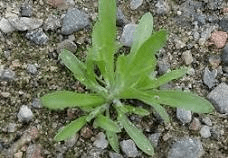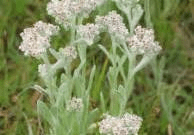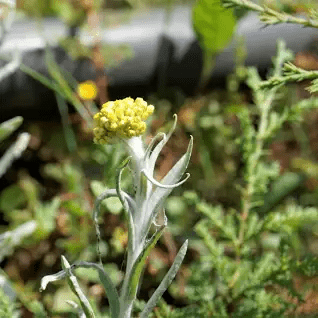The term cudweed refers to a diverse group of plants belonging to the genus Gnaphalium within the sunflower family (Asteraceae).
With over 100 species found worldwide, cudweeds exhibit a remarkable range of adaptations that allow them to thrive in various challenging environments.
The Botanical Description of Cudweed
1. Leaf Structure: Cudweed is characterized by its distinctively serrated and elongated leaves, arranged alternately along the stems. The leaves, often covered in fine hairs, contribute to the plant’s unique appearance.
2. Flower Characteristics: Cudweed produces small, inconspicuous flowers that form compact clusters. These blooms, while modest, play a crucial role in the plant’s reproductive cycle.
3. Stem Architecture: The stems of Cudweed are slender and flexible, showcasing adaptability to various environmental conditions. Their resilience allows the plant to thrive in diverse habitats.
4. Growth Form: Cudweed exhibits a low-growing and mat-forming growth habit, creating a carpet-like appearance. This adaptive growth form aids in the plant’s ability to withstand grazing and environmental pressures.
5. Habitat Preferences: Cudweed is often found in open fields, meadows, and disturbed areas. Its ability to thrive in different soil types contributes to its wide distribution.
6. Reproductive Strategies: The plant reproduces both sexually, through the production of seeds, and asexually, with the ability to regenerate from fragments of its stems.
7. Unique Adaptations: Cudweed showcases adaptations that enhance its survival, including its ability to withstand drought conditions and tolerate varying soil qualities.
8. Foliage Texture: The leaves of Cudweed have a distinct texture, often described as silky or woolly, adding to the plant’s visual appeal.
9. Seasonal Changes: Cudweed undergoes seasonal changes, with variations in color and growth patterns. These changes contribute to the plant’s resilience in different climates.
10. Taxonomic Classification: Cudweed belongs to the Asteraceae family, a diverse family that includes many plants with medicinal and ornamental value.
The Geographic Distribution of Cudweed
1. Native Regions: Cudweed is native to regions with temperate climates, including parts of Europe, Asia, and North America. Its natural distribution reflects its adaptability to a range of environmental conditions.
2. Global Presence: The plant has expanded its range beyond its native regions and can now be found
in various continents, demonstrating its successful adaptation to different ecosystems.
3. Soil Preferences: Cudweed displays versatility in soil preferences, thriving in well-drained soils but demonstrating adaptability to various soil types, including sandy and loamy substrates.
4. Altitudinal Range: Cudweed can be found at different altitudes, from lowland areas to mountainous regions. Its ability to grow in diverse elevations contributes to its widespread presence.
5. Disturbed Habitats: The plant often colonizes disturbed habitats, including fields, roadsides, and areas affected by human activities. Its resilience to environmental changes makes it a common sight in these locations.
6. Invasive Potential: In some regions, Cudweed exhibits invasive tendencies, outcompeting native vegetation. Efforts to manage its spread are essential to maintain ecological balance.
7. Biotic Interactions: Cudweed engages in various biotic interactions, serving as a food source for certain insects and herbivores. These interactions contribute to the plant’s role in local ecosystems.
8. Conservation Status: While not typically considered endangered, the impact of Cudweed on local ecosystems should be monitored to prevent unintended ecological consequences.
9. Human Utilization: In addition to its ecological role, Cudweed has historical and contemporary uses in traditional medicine, contributing to its importance in human culture.
The Chemical Composition of Cudweed
1. Sesquiterpene Lactones: Cudweed contains sesquiterpene lactones, compounds known for their anti-inflammatory and immune-modulating properties.
2. Flavonoids: The presence of flavonoids in Cudweed contributes to its antioxidant capabilities, potentially aiding in cellular protection.
3. Essential Oils: Certain species of Cudweed may contain essential oils, adding to its aromatic qualities and potential benefits.
4. Polyphenols: Polyphenolic compounds in Cudweed have been studied for their antioxidant effects, which play a role in supporting overall health.
5. Tannins: Tannins found in Cudweed contribute to its astringent properties, and they have been explored for their potential in traditional medicine.
6. Coumarins: Some species of Cudweed may contain coumarins, compounds associated with various biological activities.
7. Alkaloids: While not present in all species, certain Cudweed varieties may contain alkaloids, adding to the diversity of its chemical composition.
8. Mucilage: The presence of mucilage in Cudweed contributes to its soothing properties, potentially beneficial for certain health applications.
9. Phenolic Acids: Phenolic acids, known for their antioxidant and anti-inflammatory properties, are part of the chemical makeup of Cudweed.
10. Glycosides: The occurrence of glycosides in Cudweed adds to the complexity of its chemical profile, with potential implications for its medicinal properties.
11. Terpenoids: Certain terpenoids found in Cudweed may contribute to its aroma and could have bioactive properties.
12. Minerals: Cudweed may contain essential minerals, such as potassium and calcium, adding to its nutritional value.
Read Also: Burmese Cat Breed (Felis catus) Description and Complete Care Guide
The Medicinal Health Benefits Of Cudweed

1. Anti-Inflammatory Properties: The sesquiterpene lactones in Cudweed have been linked to anti-inflammatory effects, making it potentially beneficial for inflammatory conditions.
2. Respiratory Support: Cudweed has a traditional association with respiratory health, and its use in addressing respiratory discomfort has been documented in folk medicine.
3. Antioxidant Effects: The flavonoids and polyphenols in Cudweed contribute to its antioxidant effects, helping combat oxidative stress in the body.
4. Digestive Comfort: Certain compounds in Cudweed, including mucilage and tannins, may contribute to digestive comfort, making it valuable for gastrointestinal well-being.
5. Skin Soothing: External applications of Cudweed, owing to its mucilage content, may offer soothing effects on the skin, potentially aiding in skin irritations.
6. Immune Modulation: Components like flavonoids and terpenoids may contribute to immune modulation, supporting the body’s defense mechanisms.
7. Stress Relief: In traditional medicine, Cudweed has been used for its potential stress-relieving properties, helping individuals cope with daily pressures.
8. Wound Healing: The presence of certain compounds in Cudweed suggests potential benefits in wound healing and skin regeneration.
9. Anti-Microbial Activity: Some studies suggest that Cudweed may exhibit antimicrobial activity, making it a subject of interest in the development of natural antimicrobial agents.
10. Anti-Allergic Potential: Research indicates that certain compounds in Cudweed may have anti-allergic properties, potentially beneficial for individuals with allergies.
11. Cardiovascular Support: The antioxidant properties of Cudweed may contribute to cardiovascular health, protecting against oxidative damage in the circulatory system.
12. Analgesic Effects: In traditional practices, Cudweed has been employed for its potential analgesic effects, offering relief from pain and discomfort.
13. Antispasmodic Qualities: Certain constituents in Cudweed may possess antispasmodic properties, potentially useful in addressing muscle spasms and tension.
14. Anti-Aging Benefits: The antioxidant-rich nature of Cudweed may contribute to anti-aging effects, protecting cells from premature aging.
15. Metabolic Support: Some studies suggest a role for Cudweed in metabolic support, potentially impacting factors like blood sugar levels and lipid profiles.
16. Cognitive Well-being: Preliminary research hints at cognitive benefits, with Cudweed being explored for its potential neuroprotective effects.
17. Anti-Cancer Properties: While in the early stages of investigation, certain compounds in Cudweed show promise in preliminary studies for their potential anti-cancer properties.
18. Adaptogenic Qualities: Traditional uses of Cudweed suggest adaptogenic qualities, aiding the body in adapting to stressors and promoting overall resilience.
The Methods of Usage to Achieve the Provided Health Benefits Of Cudweed
1. Herbal Infusions: One common method involves preparing herbal infusions using Cudweed leaves. This allows for the extraction of beneficial compounds for internal use.
2. Tinctures: Cudweed tinctures are alcohol-based extracts that capture the medicinal properties of the plant. These can be taken in controlled doses.
3. Poultices: External applications of poultices made with Cudweed can offer localized relief, especially for skin issues and superficial wounds.
4. Steam Inhalation: In respiratory support, inhaling steam infused with Cudweed extracts may provide relief from congestion and respiratory discomfort.
5. Culinary Use: Depending on the variety, Cudweed may be used in culinary practices. However, caution is advised, as not all species are suitable for consumption.
6. Capsules and Tablets: Commercially available supplements, such as capsules or tablets, provide a convenient way to incorporate Cudweed into a daily health regimen.
7. Topical Creams: For skin-related benefits, topical creams or ointments containing Cudweed extracts can be applied to the affected areas.
8. Herbal Teas: Cudweed can be prepared as a herbal tea, offering a soothing and palatable way to enjoy its potential health benefits.
9. Aromatherapy: Essential oils extracted from Cudweed may be used in aromatherapy, contributing to a calming and stress-relieving atmosphere.
10. Compresses: Compresses soaked in Cudweed-infused solutions can be applied to specific areas of the body for targeted relief.
The Side Effects Of Using Cudweed Medicinal Plant
1. Allergic Reactions: Individuals with known allergies to plants in the Asteraceae family should exercise caution, as Cudweed may trigger allergic reactions.
2. Skin Sensitivity: External applications may cause skin sensitivity in some individuals. A patch test is recommended before widespread use.
3. Gastrointestinal Discomfort: In some cases, the internal use of Cudweed may lead to gastrointestinal discomfort. It’s advisable to start with small doses.
4. Interaction with Medications: Cudweed may interact with certain medications. Individuals on medication should consult healthcare professionals before incorporating it into their routine.
5. Pregnancy and Lactation: Pregnant and lactating individuals should seek medical advice before using Cudweed, as its safety during these periods is not conclusively established.
6. Photosensitivity: Some individuals may experience photosensitivity after topical application of Cudweed. Sun protection is advisable in such cases.
7. Internal Use Caution: Internal use of Cudweed should be approached with care, and consultation with a healthcare provider is recommended.
8. Quality of Plant Material: The quality of Cudweed products can vary. It’s essential to source from reputable suppliers to ensure purity and potency.
9. Drowsiness: In some individuals, Cudweed may induce drowsiness. Caution is advised, especially when operating machinery or driving.
10. Not Evaluated for Children: The safety of Cudweed for children has not been extensively evaluated. Consultation with pediatric healthcare professionals is advisable.
11. Liver Health: Individuals with liver conditions should exercise caution, as certain compounds in Cudweed may affect liver function.
12. Blood Pressure: Cudweed may impact blood pressure levels. Individuals with hypertension should monitor their blood pressure regularly.
Read Also: The Visual Symphony of Crimson and Clover
The Scientific Research and Studies of Cudweed

1. Anti-Inflammatory Effects: Scientific studies have explored the anti-inflammatory effects of Cudweed, attributing them to specific compounds.
2. Respiratory Benefits: Research indicates potential respiratory benefits, supporting traditional uses of Cudweed in addressing respiratory discomfort.
3. Antioxidant Properties: The antioxidant properties of Cudweed have been investigated, with studies highlighting its potential role in combating oxidative stress.
4. Gastrointestinal Health: Preliminary research suggests that Cudweed may contribute to gastrointestinal health, potentially alleviating digestive discomfort.
5. Immunomodulatory Effects: Certain compounds in Cudweed have been studied for their immunomodulatory effects, indicating potential support for the immune system.
6. Analgesic Properties: Some studies suggest that Cudweed may possess analgesic properties, offering relief from pain.
7. Antimicrobial Activity: Scientific exploration has revealed certain Cudweed species’ antimicrobial activity, showcasing its potential in fighting against pathogens.
8. Anti-Allergic Potential: Research has explored the anti-allergic potential of Cudweed, indicating possible benefits for individuals with allergies.
9. Cardiovascular Health: Studies hint at cardiovascular benefits, with Cudweed showing potential in supporting heart health.
10. Neuroprotective Effects: Preliminary studies suggest that certain compounds in Cudweed may have neuroprotective effects, although further research is needed.
Safety Precautions and Recommendations In Using Cudweed Medicinal Plant
1. Allergy Testing: Individuals with known allergies to Asteraceae family plants should perform allergy testing before using Cudweed.
2. Consultation with Healthcare Professionals: Individuals with existing medical conditions, pregnant or lactating individuals, and those on medication should consult healthcare professionals before using Cudweed.
3. Dose Moderation: Start with small doses when using Cudweed internally and monitor for any adverse reactions. Adjust the dose gradually if needed.
4. Quality Sourcing: Ensure that Cudweed products are sourced from reputable suppliers to guarantee purity and quality.
5. External Application Patch Test: Before widespread external use, conduct a patch test to check for any skin sensitivity or adverse reactions.
6. Sun Protection: If using Cudweed topically, consider sun protection measures, as it may cause photosensitivity in some individuals.
7. Children and Elderly: Use caution when considering Cudweed for children or elderly individuals, and consult healthcare professionals for guidance.
8. Monitoring Blood Pressure: Individuals with hypertension should monitor their blood pressure regularly if using Cudweed, as it may impact blood pressure levels.
9. Liver Health: Those with liver conditions should exercise caution, as Cudweed may affect liver function. Regular monitoring is advisable.
10. Not a Substitute for Professional Medical Advice: Cudweed should not be considered a substitute for professional medical advice, diagnosis, or treatment. It complements, but does not replace, standard healthcare practices.
11. Awareness of Individual Sensitivity: Each individual may react differently to Cudweed. It’s crucial to be aware of personal sensitivities and adjust usage accordingly.
12. Pregnancy and Lactation Guidance: Pregnant and lactating individuals should seek guidance from healthcare professionals to ensure the safety of using Cudweed during these periods.
FAQs About Cudweed Medicinal Plant
1. Is Cudweed Safe for Regular Consumption?
While Cudweed is generally considered safe when used appropriately, moderation is key. Excessive consumption may lead to adverse effects. It’s advisable to consult healthcare professionals for personalized guidance.
2. Can Cudweed Be Used by Children?
Caution is advised when considering Cudweed for children. Consultation with pediatric healthcare professionals is recommended to ensure safety and appropriate dosages.
3. What Is the Best Way to Prepare Cudweed Tea?
To prepare Cudweed tea, steep dried Cudweed leaves in hot water for about 5-10 minutes. Strain the tea and sweeten with honey if desired. The tea can be consumed for its potential health benefits.
4. Are There Different Species of Cudweed With Varying Properties?
Yes, there are different species of Cudweed, and their properties may vary. It’s essential to identify the specific species being used and understand its unique characteristics and potential benefits.
5. Can Cudweed Be Applied Topically for Skin Conditions?
Cudweed’s soothing properties make it a candidate for topical applications. However, a patch test is recommended to check for any skin sensitivity or allergic reactions. Consultation with dermatological professionals is advisable for specific skin conditions.
6. How Does Cudweed Contribute to Respiratory Health?
Cudweed has traditional uses for respiratory support. Scientific studies suggest potential anti-inflammatory and expectorant properties, making it beneficial for respiratory conditions. Inhalation of steam infused with Cudweed extracts is one method of utilization.
7. Can Cudweed Help Alleviate Stress and Anxiety?
While traditional uses suggest stress relief properties in Cudweed, scientific evidence supporting its efficacy for stress and anxiety is limited. It may contribute to relaxation, but individuals seeking specific stress management benefits should explore a comprehensive approach that may include professional guidance.
8. Is Cudweed Safe for Pregnant Women?
Pregnant individuals should exercise caution when considering Cudweed. While there’s limited evidence on its safety during pregnancy, it’s advisable to consult healthcare professionals before use to ensure the well-being of both the mother and the developing fetus.
9. How Does Cudweed Impact Allergies?
Cudweed, belonging to the Asteraceae family, may trigger allergic reactions in individuals sensitive to this plant family. Allergy testing is recommended before using Cudweed to identify potential sensitivities.
10. Can Cudweed Be Used for Pain Relief?
Certain compounds in Cudweed suggest potential analgesic effects. However, the extent of its pain-relieving properties may vary among individuals. Consulting healthcare professionals for personalized pain management strategies is advisable.
11. What Is the Best Time to Consume Cudweed Tea?
Cudweed tea can be consumed at various times, and the choice may depend on personal preferences. Some individuals find it soothing in the evening, while others may benefit from its potential energizing properties during the day. Experimenting with timing can help determine the most suitable schedule.
12. Are There Any Known Drug Interactions with Cudweed?
Cudweed may interact with certain medications. Individuals taking prescription drugs should consult healthcare professionals to assess potential interactions and ensure the safe use of Cudweed alongside medications.
13. Can Cudweed Be Combined with Other Herbs for Enhanced Benefits?
Combining Cudweed with other compatible herbs may enhance its overall benefits. However, it’s crucial to understand potential interactions and dosage considerations. Seeking guidance from herbalists or healthcare professionals experienced in herbal medicine can provide tailored advice.
14. How Long Does It Take to Experience the Medicinal Effects of Cudweed?
The time it takes to experience the medicinal effects of Cudweed can vary among individuals. Factors such as dosage, method of usage, individual health status, and the specific health concern being addressed can influence the timeframe. Patience and consistent use, in accordance with recommended guidelines, are essential for optimal results.
15. Can Cudweed Be Used for Allergic Skin Reactions?
While Cudweed has soothing properties, it’s essential to conduct a patch test before using it for allergic skin reactions. Individual responses may vary, and consulting dermatological professionals is advisable for personalized guidance on skin-related concerns.
Read Also: Complete Steps in Aluminum Recycling Guide

